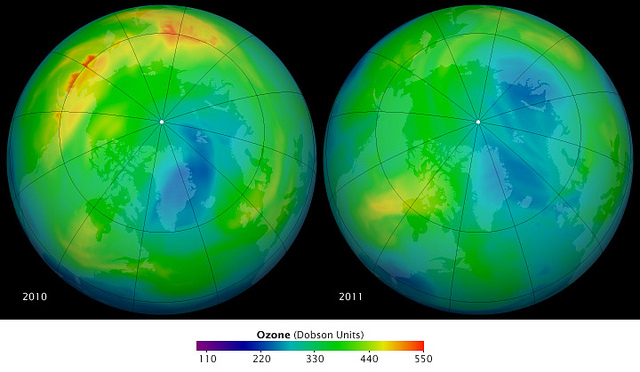Did you know that today is International Ozone Day?
16 September is Ozone Day and on this day you should take some time to remind those around you of the need to protect this valuable shield that safeguards our planet.
On 19 December 1994, the United Nations General Assembly proclaimed 16 September the International Day for the Preservation of the Ozone Layer, commemorating the date, in 1987, on which, according to *UNEP, the Montreal Protocol on Substances that Deplete the Ozone Layer was signed.
Above: These maps of ozone concentrations over the Arctic come from the Ozone Monitoring Instrument (OMI) on NASA’s Aura satellite. The left image shows March 19, 2010, and the right shows the same date in 2011. March 2010 had relatively high ozone, while March 2011 has low levels. What these readings mean for the long-term is that the recovery from human-induced ozone depletion is an uneven climb. Photo by: NASA Goddard Photo and Video
The ozone layer, the invisible shield that protects all living things from the sun’s harmful ultraviolet rays, started its decline because of ozone-depleting substances used around the world. By signing the Protocol, governments set a precedent for further international cooperation in dealing with a global environmental threat by phasing out ozone-depleting chemicals. According to Cape Town Green Map, South Africa acceded to the Protocol in 1990.
10 Tips to save the ozone layer
Everyone should be responsible for the use and abuse of certain products that have a negative effect on nature. It seems that chlorofluorocarbon (CFC)
causes the most damage, but there are other products and habits that also have a negative impact.
- Avoid buying and using aerosols and sprays composed of chlorofluorocarbon (CFC).
- Avoid using fire extinguishers with halogenated hydrocarbon since it is a very aggressive substance for the ozone layer.
- Avoid buying insulating material made up of CFC.
- Keep air-conditioning clean otherwise it emits CFC to the atmosphere.
- Opt to buy a refrigerator or an air-conditioning without CFC.
- Reduce the use of your car and of other gadgets.
- Use alternative means of transport: buses, bicycles, or simply walk.
- Reduce the use of heating and air-conditioning.
- Buy energy saving gadgets and bulbs.
- Arrange an itinerary to save time and money if you have to use your car.
As Mahatma Gandhi once said: be the change you want to see. By making small changes in your everyday life, you can make a difference.
* UNEP = United Nations Environment Programme
Another way to make a difference when travelling is to rent a vehicle with low Co2 emissions. Opt for a smaller vehicle with less impact on the environment. Car rental South Africa can help with that.
Related Posts
K-Day Festival
South Africa's best artists and bands will be performing at the K-Day Festival. The event will be hosted by Santam and KFM radio stations and is perfect for a day out for the whole family.
Read MoreWhy You Should Visit Kruger National Park
Picture this: A fierce red sun kisses the horizon as the last rays of daylight bathe the camelthorn trees around you in a warm glow. At the waterhole in front of you a mother elephant helps her newborn take a mud bath while an elegant giraffe kneels nearby for a drink. You sip a sundowner […]
Read MoreBest Time To Visit Cape Town
Cape Town, known to locals as The Mother City. And rightfully so. This is where Jan van Riebeeck of the Dutch East India Company first set foot in South Africa back in April 1652. Cape Town was the largest town in South Africa until Johannesburg developed around 1886 due to the Witwatersrand Gold Rush. […]
Read More Rating: 4 - 1562 Reviews
Rating: 4 - 1562 Reviews



